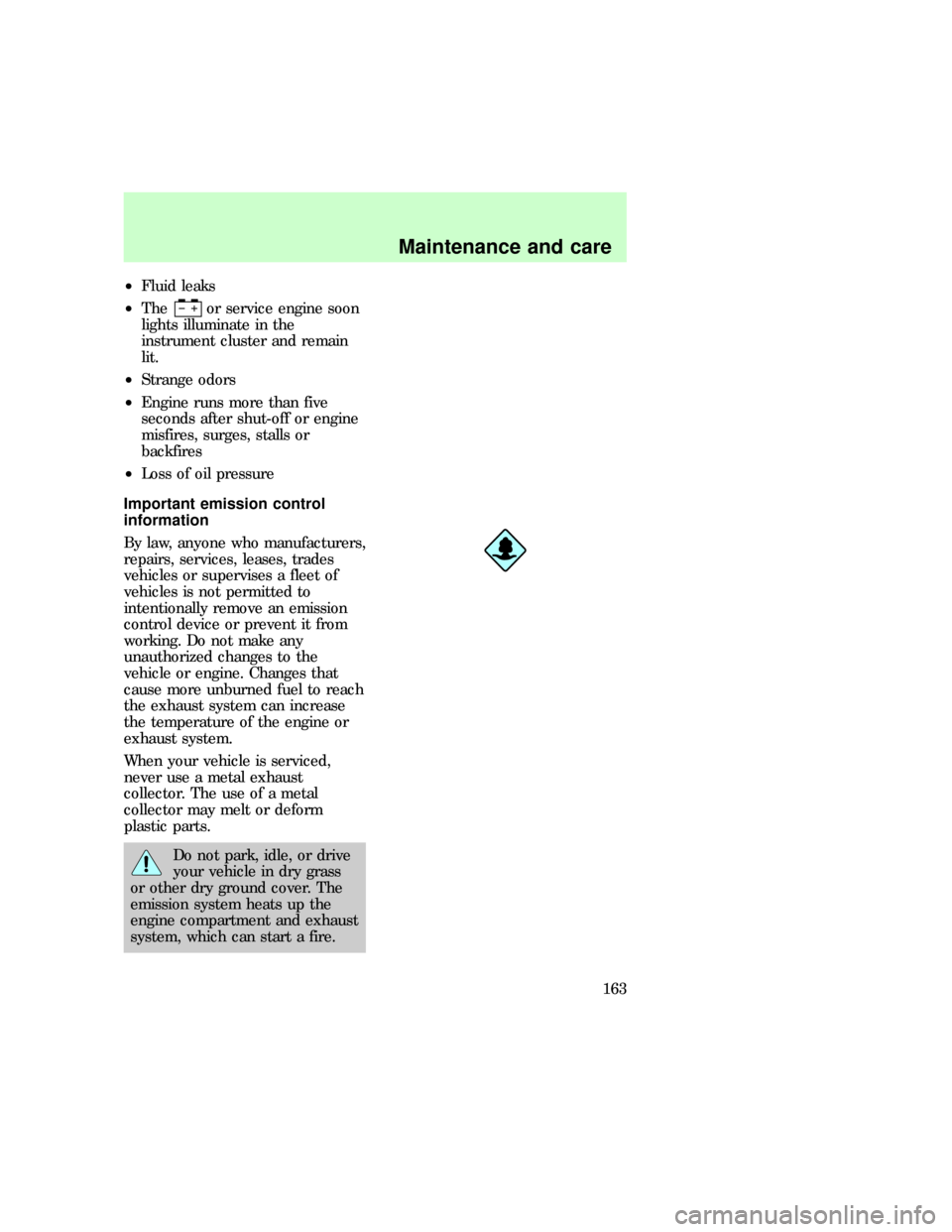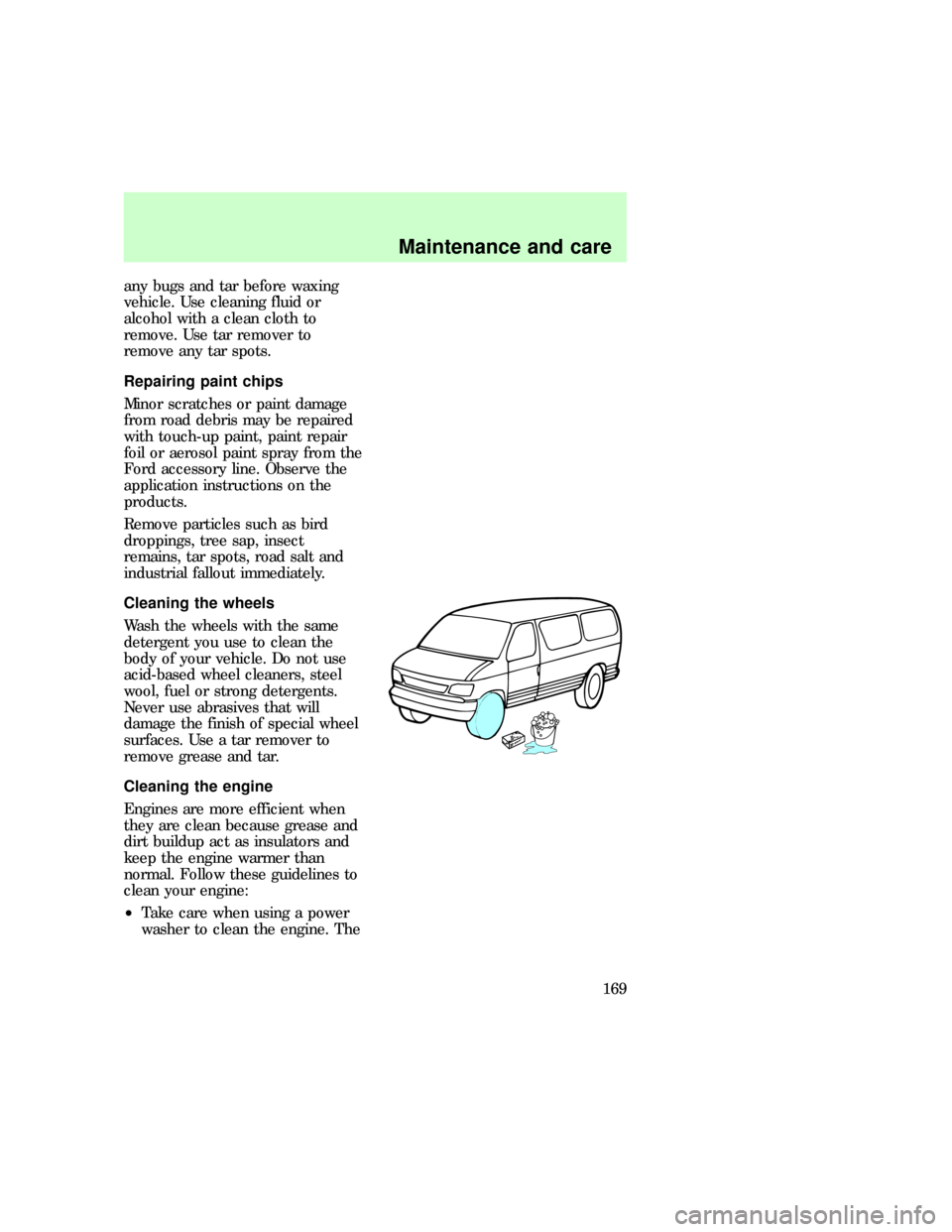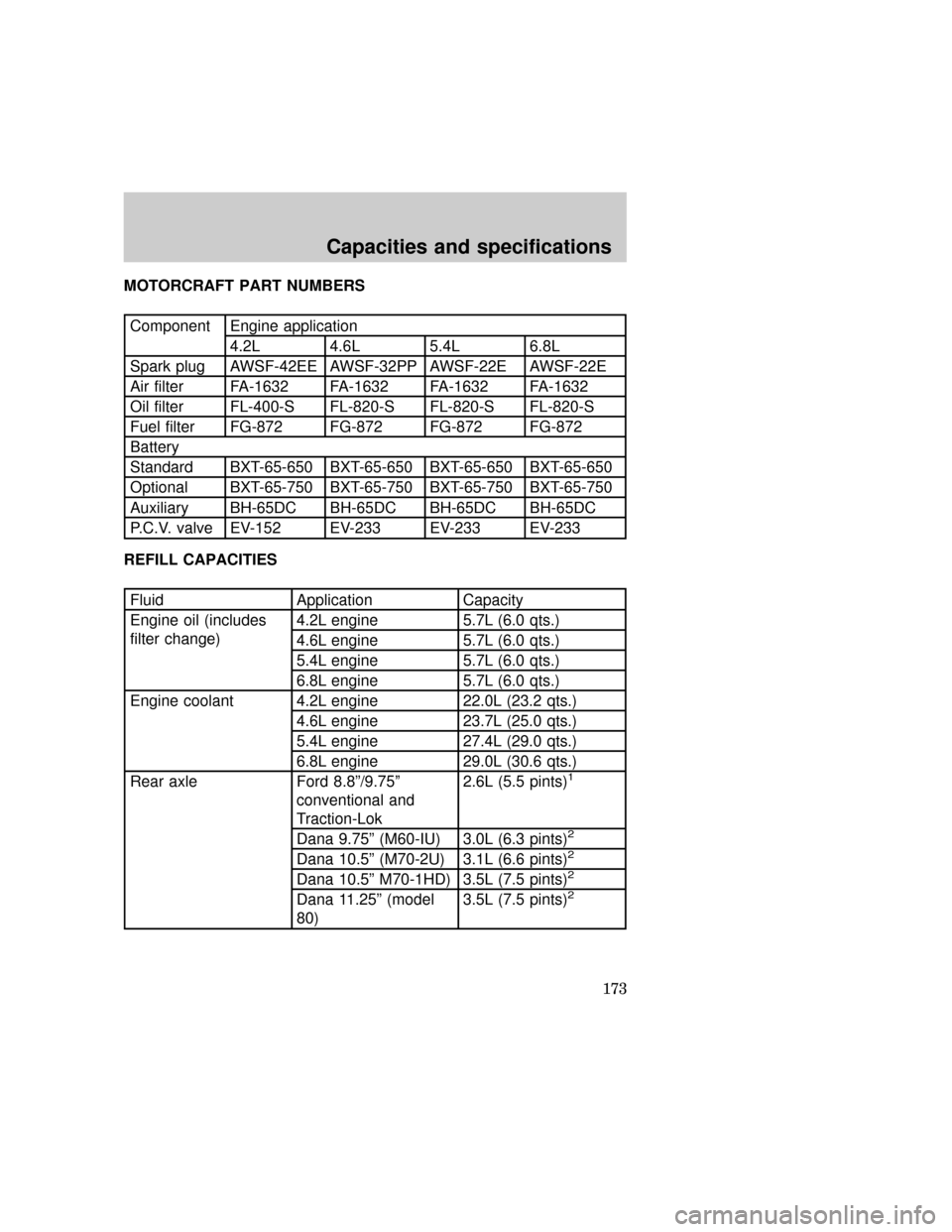Page 161 of 192

1. Fill the tank completely and
record the initial odometer
reading.
2. Each time you fill the tank,
record the amount of fuel added
(in liters or gallons).
3. After at least three to five fuel
tank fill-ups, fill the fuel tank and
record the current mileage
reading.
4. Use one of the following
equations to calculate fuel
economy.
Liters used x 1004Total
kilometers traveled
Total miles traveled4Total
gallons used
Keep a record for at least one
month. This will provide an
accurate estimate of the vehicle's
fuel economy.
WHAT YOU SHOULD KNOW
ABOUT THE EMISSION
CONTROL SYSTEM
Your vehicle is equipped with a
catalytic convertor which enables
your vehicle to comply with
applicable exhaust emission
requirements. For more
information on your vehicle's
emission control system, see the
Vehicle Emission Control
Information decal located on the
left side of the engine
compartment.
Follow these guidelines to ensure
proper emission system operation:
eco_emission_control
Maintenance and care
161
Page 162 of 192
²Use only unleaded fuel.
²Avoid running out of fuel.
²Do not turn off the ignition
while the vehicle is in motion.
²Have regular maintenance
checks performed according to
the intervals in theService
Guide.
When servicing your vehicle, never
use a metal exhaust collector. A
metal collector may melt or deform
plastic parts.
Do not park, idle, or drive
your vehicle in dry grass
or other dry ground cover. The
emission system heats up the
engine compartment and exhaust
system, which can start a fire.
If you smell exhaust fumes
inside your vehicle, have
your dealer inspect your vehicle
immediately. Do not drive if you
smell exhaust fumes.
On vehicles without
original equipment floor
covering or insulation, do not let
passengers ride in your truck in
a manner that allows contact
between skin and the metal floor.
If you notice one or more of the
following, the emissions system
may not be working properly. Have
your vehicle serviced as soon as
possible.
Maintenance and care
162
Page 163 of 192

²Fluid leaks
²The
or service engine soon
lights illuminate in the
instrument cluster and remain
lit.
²Strange odors
²Engine runs more than five
seconds after shut-off or engine
misfires, surges, stalls or
backfires
²Loss of oil pressure
Important emission control
information
By law, anyone who manufacturers,
repairs, services, leases, trades
vehicles or supervises a fleet of
vehicles is not permitted to
intentionally remove an emission
control device or prevent it from
working. Do not make any
unauthorized changes to the
vehicle or engine. Changes that
cause more unburned fuel to reach
the exhaust system can increase
the temperature of the engine or
exhaust system.
When your vehicle is serviced,
never use a metal exhaust
collector. The use of a metal
collector may melt or deform
plastic parts.
Do not park, idle, or drive
your vehicle in dry grass
or other dry ground cover. The
emission system heats up the
engine compartment and exhaust
system, which can start a fire.
eco_emission_info
eco_i-m_testing
Maintenance and care
163
Page 169 of 192

any bugs and tar before waxing
vehicle. Use cleaning fluid or
alcohol with a clean cloth to
remove. Use tar remover to
remove any tar spots.
Repairing paint chips
Minor scratches or paint damage
from road debris may be repaired
with touch-up paint, paint repair
foil or aerosol paint spray from the
Ford accessory line. Observe the
application instructions on the
products.
Remove particles such as bird
droppings, tree sap, insect
remains, tar spots, road salt and
industrial fallout immediately.
Cleaning the wheels
Wash the wheels with the same
detergent you use to clean the
body of your vehicle. Do not use
acid-based wheel cleaners, steel
wool, fuel or strong detergents.
Never use abrasives that will
damage the finish of special wheel
surfaces. Use a tar remover to
remove grease and tar.
Cleaning the engine
Engines are more efficient when
they are clean because grease and
dirt buildup act as insulators and
keep the engine warmer than
normal. Follow these guidelines to
clean your engine:
²Take care when using a power
washer to clean the engine. The
com_repairing_chips
com_wheels_cleaning.01
com_engine_cleaning.01
Maintenance and care
169
Page 171 of 192
Cleaning the wiper blades
If the wiper blades do not wipe
properly, clean both the windshield
and wiper blades using undiluted
windshield wiper solution or a mild
detergent. Rinse thoroughly with
clean water. To avoid damaging the
blades, do not use fuel, kerosene,
paint thinner or other solvents.
Cleaning the instrument panel
Clean instrument panel with a
damp cloth, then dry with a dry
cloth.
Any cleaner or polish that
increases the gloss of the upper
portion of the instrument panel
should be avoided. The dull finish
in this area is to help protect the
driver from undesirable windshield
reflection.
Cleaning the interior fabric
Remove dust and loose dirt with a
whisk broom or a vacuum cleaner.
Remove fresh spots immediately.
Follow the directions that come
with the cleaner.
com_instru-panel_cleaning.01
com_int_fabric_cleaning.01
com_safety_belts_cleaning.01
Maintenance and care
171
Page 173 of 192

MOTORCRAFT PART NUMBERS
Component Engine application
4.2L 4.6L 5.4L 6.8L
Spark plug AWSF-42EE AWSF-32PP AWSF-22E AWSF-22E
Air filter FA-1632 FA-1632 FA-1632 FA-1632
Oil filter FL-400-S FL-820-S FL-820-S FL-820-S
Fuel filter FG-872 FG-872 FG-872 FG-872
Battery
Standard BXT-65-650 BXT-65-650 BXT-65-650 BXT-65-650
Optional BXT-65-750 BXT-65-750 BXT-65-750 BXT-65-750
Auxiliary BH-65DC BH-65DC BH-65DC BH-65DC
P.C.V. valve EV-152 EV-233 EV-233 EV-233
REFILL CAPACITIES
Fluid Application Capacity
Engine oil (includes
filter change)4.2L engine 5.7L (6.0 qts.)
4.6L engine 5.7L (6.0 qts.)
5.4L engine 5.7L (6.0 qts.)
6.8L engine 5.7L (6.0 qts.)
Engine coolant 4.2L engine 22.0L (23.2 qts.)
4.6L engine 23.7L (25.0 qts.)
5.4L engine 27.4L (29.0 qts.)
6.8L engine 29.0L (30.6 qts.)
Rear axle Ford 8.8º/9.75º
conventional and
Traction-Lok2.6L (5.5 pints)
1
Dana 9.75º (M60-IU) 3.0L (6.3 pints)2
Dana 10.5º (M70-2U) 3.1L (6.6 pints)2
Dana 10.5º M70-1HD) 3.5L (7.5 pints)2
Dana 11.25º (model
80)3.5L (7.5 pints)2
eco_motorcraft_part_numbers
eco_refill_capacities
Capacities and specifications
173
Page 174 of 192
Fluid Application Capacity
Transmission3Automatic (4R70W) 13.1L (13.9 qts.)
Automatic (E4OD) 15.0L (15.9 qts.)
Fuel 138º wheelbase
(except E-Super Duty)132.5L (35.0 gal.)
158º wheelbase
(except E-Super Duty)140L (37.0 gal.)
4
176º wheelbase
(except E-Super Duty)140L (37.0 gal.)4
158º wheelbase
(E-Super Duty)208L (55 .0 gal.)
176º wheelbase
(E-Super Duty)208L (55 .0 gal.)
1Fill 6.4 mm to 14.2 mm (1/4º to
9/16º) below bottom of fill hole.
2Fill Dana rear axles to 1/4º to 3/4º
below bottom of fill hole.
3Always use dipstick to determine
exact fluid requirement.
4Optional tank, 208L (55 gal.).
LUBRICANT SPECIFICATIONS
Item Ford part name Ford part
numberFord
specification
Brake master
cylinderHigh
Performance
DOT 3 Motor
Vehicle Brake
FluidC6AZ-19542-AB ESA-M6C25-A,
DOT 3
Door
weatherstripsSilicone
LubricantC0AZ-19553-AA
and
D7AZ-19553-AAESR-M13P4-A
eco_lubricant_specifications
Capacities and specifications
174
Page 177 of 192
complete refill of Dana
Traction-Lok rear axles.
ENGINE DATA
4.2L ENGINE
Displacement 4.2L (256 cid) V6
Bore X Stroke 96.8 x 95.0 mm (3.81 x 3.74 in.)
Induction Sequential multi-port fuel injection
Ignition Electronic distributorless ignition system
(EDIS)
Firing order 1-4-2-5-3-6
Spark plug gap 1.37 mm (.054 in.)
Compression ratio 9.2:1
4.6L ENGINE
Displacement 4.6L (281 cid) V8
Bore X Stroke 90.2 x 90.0 mm (3.55 x 3.55 in.)
Induction Sequential multi-port fuel injection
Ignition Electronic distributorless ignition system
Firing order 1-3-7-2-6-5-4-8
Spark plug gap 1.37 mm (.054 in.)
Compression ratio 9.0:1
5.4L ENGINE
Displacement 5.4L (330 cid) V8
Bore X Stroke 90.2 x 105.8 mm (3.55 x 4.17 in.)
Induction Sequential multi-port fuel injection
Ignition Coil on plug
Firing order 1-3-7-2-6-5-4-8
Spark plug gap 1.37 mm (.054 in.)
Compression ratio 9.0:1
eco_engine_data
eco_engine_data_4.2
eco_engine_data_4.6
eco_engine_data_5.4
Capacities and specifications
177